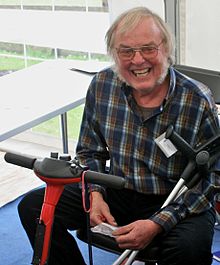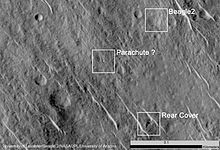Colin Pillinger
Colin Trevor Pillinger , CBE , FRS , FRGS , FRAS (born May 9, 1943 in Kingswood , Gloucestershire , † May 7, 2014 in Cambridge ) was a British planetologist who became known worldwide as the project manager and public face of Beagle 2 , the 2003 mission to find life on Mars . Although the mission was ultimately unsuccessful and received much criticism and ridicule, Pillinger insisted that the mission was not a failure.
Life
Study and staff at NASA
Pillinger, the son of a gasworker and a housewife, grew up in the working-class neighborhood of Kingswood on the outskirts of Bristol and completed his education at Kingswood Grammar School . He then studied chemistry at the University College of Swansea , from which he graduated in 1965 with a Bachelor of Science (B.Sc. Chemistry). After earning a doctorate in chemistry in 1968 he was a research scientist (Research Fellow ) at the University of Cambridge .
In 1969 Pillinger moved to NASA , where he analyzed samples of lunar rocks that were collected by Apollo 11 during the moon landing . He then worked on the subsequent missions of the Apollo program .
After his return to Great Britain, he resumed his work as a research scientist at the University of Cambridge in 1974 and in 1976 became chief research scientist at the Department of Earth Sciences there . In 1984, Pillinger, a 1981 Fellow of the Royal Astronomical Society (FRAS) and an honorary doctorate in chemistry from the University of Bristol in 1984 , became Senior Research Scientist at The Open University in Milton Keynes .
In 1991 Pillinger accepted a professorship for interplanetary sciences at the Open University, where he was also head of the department for physical sciences until 2005. In addition, he became a member of the International Astronomical Union (IAU) and a Fellow of the Royal Geographical Society (FRGS) and the Royal Society (FRS) in 1993 . In addition, he was Professor at the Chair of Astronomy at Gresham College between 1996 and 2000 .
Beagle 2
The Beagle 2 project, named by his wife in memory of Charles Darwin's HMS Beagle , was inspired by his analysis of lunar rocks and chunks of Martian meteorites , which he believed contained evidence of micro-organic traces and thus probably evidence of life on the Mars. Pillinger and his team at the Open University developed technologies that enabled them to take far smaller samples and analyze them in far greater detail. Beagle 2, a robot developed to search for life , was the size of a car wheel, weighed 30 kilograms and contained, among other things, a mass spectrometer , an optical microscope , binocular "eyes" , a rock-collecting drill and a telescopic "mole" that you can use up to was able to drill 1.5 meters under adjacent rock layers.
On June 2, 2003, Beagle 2 was transported into space on a Soyuz rocket from the Baikonur spaceport on the back of a Marsexpress probe of the European Space Agency (ESA) in cooperation with the University of Leicester . Beagle 2 was expected to land on Mars on December 25, 2003; however, it initially disappeared without a trace. It was last tracked towards Mars on December 19, 2003 after it separated from its ESA mother ship. For a long time it was suspected that it crashed into a planetary crater. Some team members then examined NASA information to find evidence of its whereabouts.
After more than eleven years in which the probe was considered lost, and nine months after the death of Colin Pillinger, the landing site of Beagle 2 at position 11.5 ° north on June 29, 2014 was recorded by the Mars Reconnaissance Orbiter and 90.4 ° East can be located. The picture shows the apparently gently landed probe, the solar panels of which are only partially open. However, for the lander's antenna to work, all solar panels would have to open. The parachute and a cover could also be identified in the immediate vicinity.
However, the reason for the failure was never discovered. An investigation was launched that placed part of the blame on Pillinger's project management team and found that the team was too small. Pillinger replied that he was just the "front man" of the project, and that everyone involved was an expert. The failure of Beagle 2 was not a one-off, as out of 44 Mars missions only 18 had achieved their goals and objectives. He urged space agencies to continue what he called the 'unfinished business on Mars' and was often critical of the delays in Europe's next Mars mission, ExoMars , scheduled for 2018.
In 2003 he was appointed Commander of the Order of the British Empire (CBE).
Five years after the mission, pieces of equipment on Beagle 2 were considered potentially sufficient to make diagnoses of tuberculosis faster than before. Pillinger had received research funding from the Wellcome Trust to investigate whether the mass spectrometer they had donated to identify and qualify unknown compounds would be suitable for use in medical problems. Due to its lightness and robustness, it was able to withstand the extreme cold on Mars as well as the extreme heat during sterilization . The Wellcome Trust, as well as the Open University research group led by Geraint Morgan, found it could be used in the diagnosis of tuberculosis, which killed 1.8 million people worldwide in 2008, with final tests still ongoing.
The asteroid (15614) Pillinger was named after Pillinger, who received numerous awards such as the Space Achievement Medal and the Arthur C. Clarke Prize . In 2005 he was diagnosed with multiple sclerosis . In 2011 he was awarded the Michael Faraday Prize of the Royal Society .
He died of complications from an intracerebral hemorrhage .
Publications
- Beagle: from sailing ship to Mars spacecraft . XNP Productions, Milton Keynes 2003, ISBN 0-571-22323-0 .
Web links
- Professor Colin Pillinger - obituary. Professor Colin Pillinger was the scientist whose mission to Mars ended in disaster but proved a hit with the British public . In: The Daily Telegraph, May 8, 2014
- Colin Pillinger obituary. Scientist determined to launch his Beagle 2 Mars probe in spite of space bureaucracy . In: The Guardian, May 8, 2014
- Colin Pillinger: British Mars pioneer has died . In: Süddeutsche Zeitung of May 8, 2014
- Professor Colin Pillinger ( British Interplanetary Society obituary, May 8, 2014)
- Beagle 2 Lander Champion Colin Pillinger Dies at 70 (spacenews.com of May 8, 2014)
- “Mars Professor” Colin Pillinger has died . In: Die Presse on May 8, 2014
- Professor Colin Pillinger obituary: Scientist who became the public face of 'Beagle 2', the unsuccessful British mission to land a spacecraft on Mars . In: The Independent of May 9, 2014
Individual evidence
- ↑ a b Stefan Deiters: Lander Beagle 2 tracked down after eleven years. MARS EXPRESS. astronews.com, January 16, 2015, accessed January 17, 2015 .
- ↑ Beagle 2 Lander on Mars, With Panels Deployed. NASA , January 16, 2015, accessed June 23, 2017 .
- ↑ 'Lost' 2003 Mars Lander Found by Mars Reconnaissance Orbiter. NASA , January 16, 2015, accessed June 23, 2017 .
| personal data | |
|---|---|
| SURNAME | Pillinger, Colin |
| ALTERNATIVE NAMES | Pillinger, Colin Trevor (full name) |
| BRIEF DESCRIPTION | British chemist, geoscientist and astronomer |
| DATE OF BIRTH | May 9, 1943 |
| PLACE OF BIRTH | Kingswood , Gloucestershire |
| DATE OF DEATH | May 7, 2014 |
| Place of death | Cambridge |


